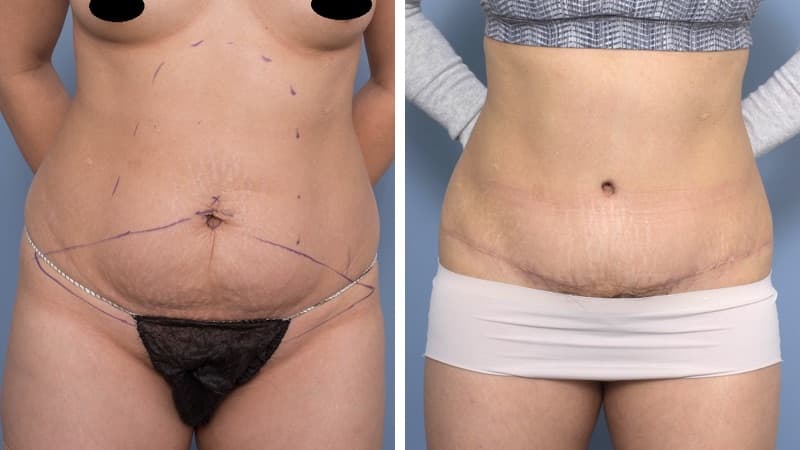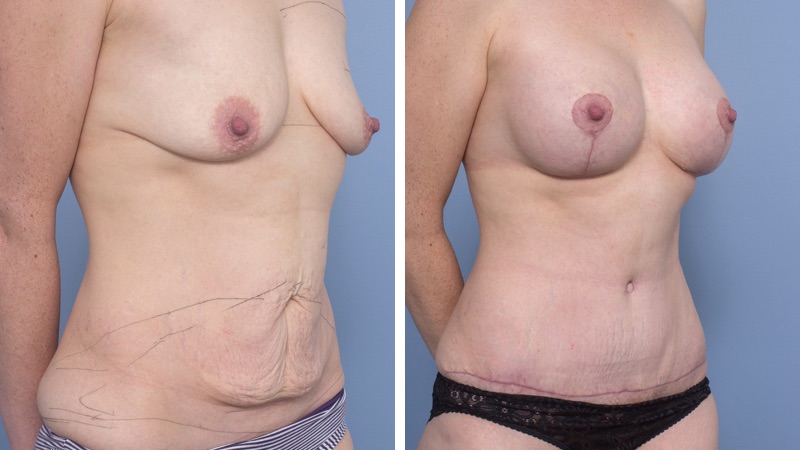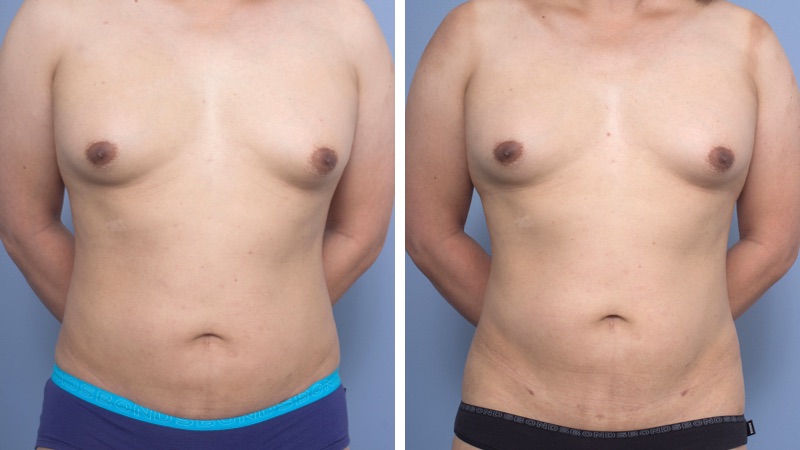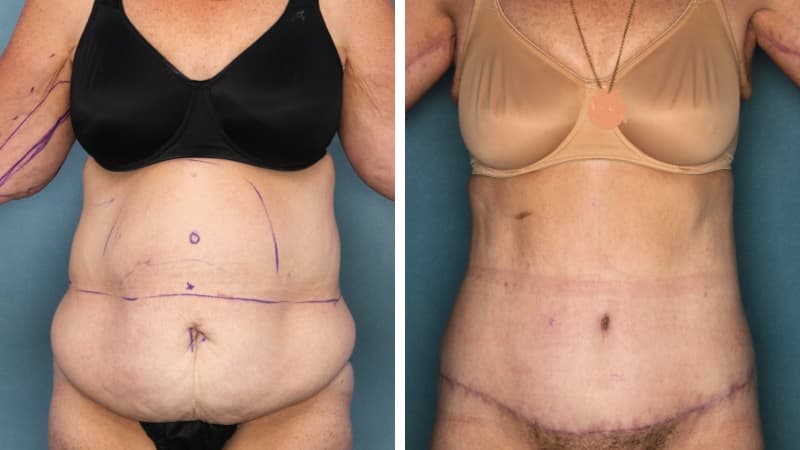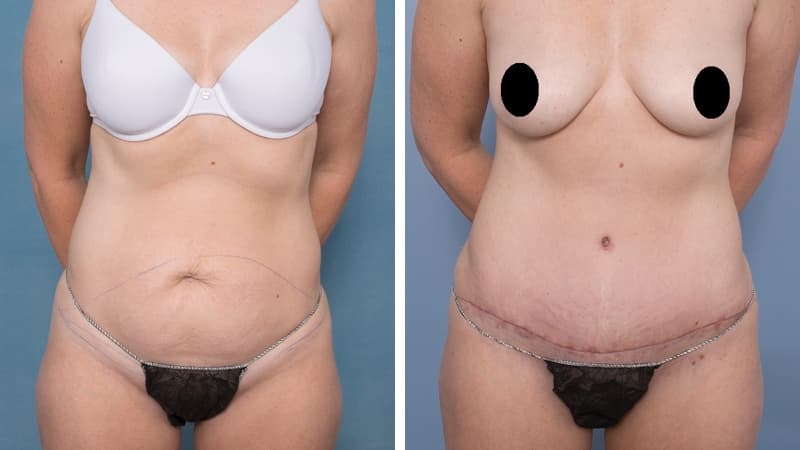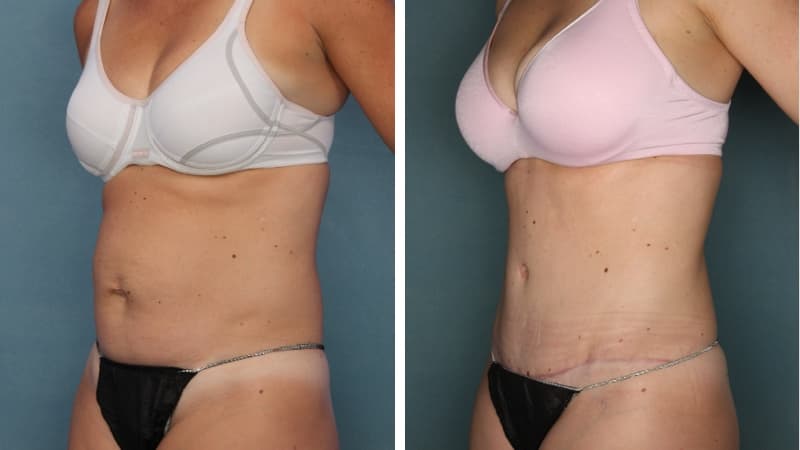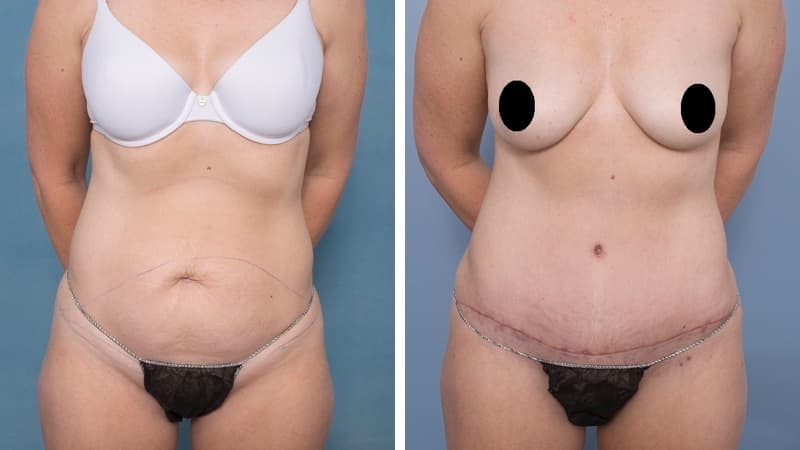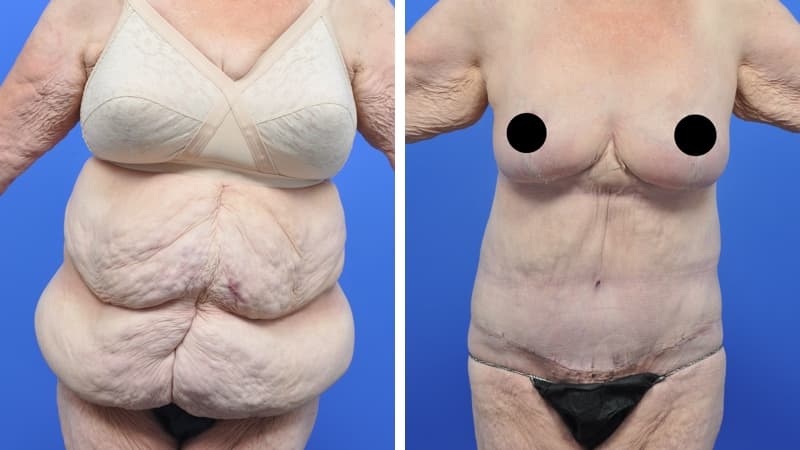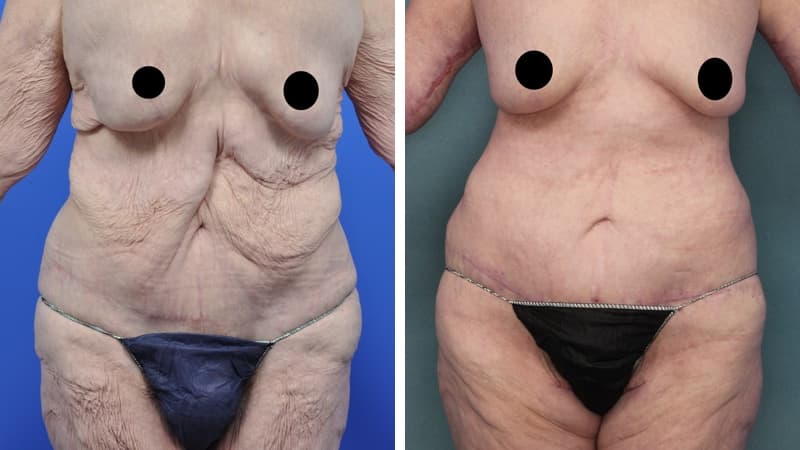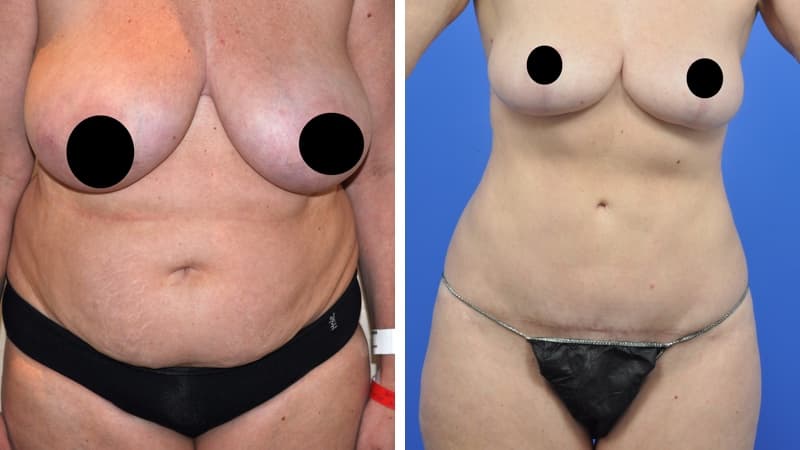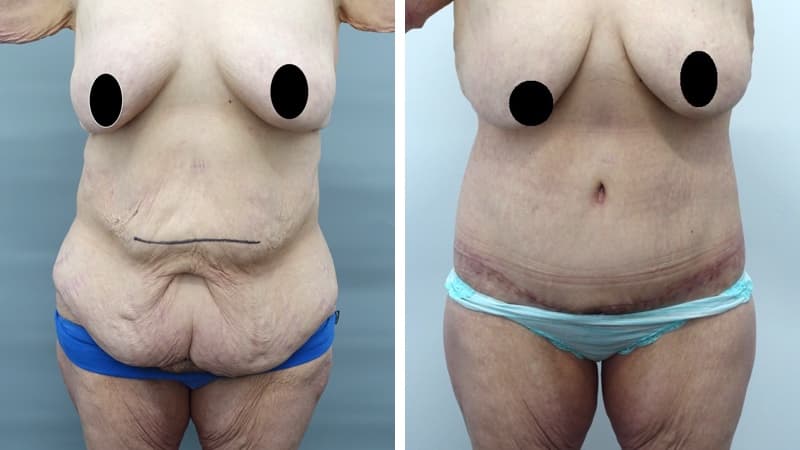The basics
Weight loss, pregnancies and natural ageing can cause sagging skin in areas below the waist. Overhanging skin in the lower body can limit mobility and cause painful chafing, rashes or infection.
If the loose skin is only at the front, you won’t need a body lift – a tummy tuck is what is needed. But if your loose skin extends around your sides and onto your back, then a tummy tuck will not give you a good result – you need a body lift, which is really extending a tummy tuck so it shapes you all the way around to the back.
A body lift is a surgical procedure that removes excess skin and fatty tissue from the middle and lower abdomen, hips, outer thighs, lower back, and buttocks. If necessary it can also repair stretched tissue of the abdominal wall (rectus diastasis). If a ventral hernia is present (a hernia along the front of your abdominal wall, or around the belly button), it can be repaired with a body lift.
A body lift is really a combination of three procedures – a tummy tuck, a thigh lift and a buttock lift. It is used to treat loose and sagging skin in these areas.
A low, horizontal incision is used, that extends around to the lower back. It is similar to a tummy tuck incision but the incision extends around to the back, and often all the way around. It is used to improve the appearance of the sides of the body and the back, as well as the front of the abdomen. Scar position is key in body lift surgery. The scar can usually be covered by underwear. If it is a long scar and placed in the right position, it won’t be visible in clothes or in most types of swimwear.
A lower body lift is appropriate if you are near your ideal weight.
Pros
- Loose skin will be removed and your contour will be sculpted, so you can see the results of your weight loss.
- You will get rid of overhanging skin that may cause painful chafing, rashes and infections.
Cons
- This is a demanding surgical procedure with substantial recovery time.
- You will have a scar that will be hidden in the bikini line.
Surgical plans are customised to the individual and they may include skin and fat removal, liposuction, deep support structure stabilisation, hernia repairs and rectus diastasis repairs. Skin removal is carefully designed to ensure the scar is placed in the ideal location, where it is easiest to hide.
What can I expect to achieve?
MWL patients are usually very happy with the results of their surgery. The lifting, and skin and fat reduction effect from a body lift is permanent. The contouring achieved by removal of excess skin and fat is also permanent.
There may be long scars in many places, but the body shape is much improved, with a slimmer figure and hanging skin removed. It’s also important to realise that skin elasticity cannot be restored, even though the excess skin is removed. This may mean that some areas of the body remain slightly loose. I will specifically discuss this with patients if it is likely to be an issue.
Note that that this type of surgery normally aims to create an excellent shape when clothed. Scars are usually quite visible when you are naked.
There is always some relaxation of the skin in the first months after surgery. Sometimes, I plan to take additional lower abdominal skin out six to twelve months after surgery, to further tighten the area, and I will have discussed the chances of needing to do this before your surgery.
Your skin and connective tissues will loosen and sag gradually as you age. If you gain weight after the surgery, the operated areas will get larger and the weight gain may reduce the quality of the result.
For MWL patients, correcting sagging skin is the last step in a long journey and finally ends years of dissatisfaction. They can now do the things most people take for granted, like buying normal clothes and exercising comfortably.
Can a body lift be combined with other surgeries?
Sometimes a body lift can be combined with other forms of body contouring surgery, including liposuction, or performed at the same time as other elective surgeries.
However, the procedure is often a large one, and if so it is safer to do just the body lift in a single operation. During the assessment process, I will decide whether it is appropriate for your health and safety to carry out other procedures at the same time.
Are there any alternative treatments to a body lift?
If you are looking to resolve issues with your body shape, there are not really any alternative treatments to a body lift. The only other option is to leave the areas of loose skin and fatty deposits as they are, or to repair the abdominal wall.
Liposuction may be a surgical alternative to a body lift if there is good skin tone and localised abdominal fatty deposits in a person of normal weight. Diet and exercise may help reduce the overall amount of excess body fat and improve the contour of the body.
What happens before surgery?
We will organise an elastic pressure garment for you to wear when surgery is over.
If you smoke you must cease all nicotine products a minimum of two weeks before surgery. If you’re unable to do this, the surgery will be cancelled. Complications of this surgery have been reported to be up to 40% more common in smokers, so it is not in your interest that I proceed if you’re still smoking.
Medication containing aspirin should not be taken for a minimum of 10 days before surgery. If you take any other blood-thinning medication, we will decide on a management plan before surgery.
You should have blood tests around a month before surgery, including an FBE and nutritional parameters. We will assist with this if your GP can’t.
We will also advise you on how to manage pain and constipation in the postoperative period.
For three days before the surgery, you should use a daily antibacterial wash in the shower, paying careful attention to the groin area. Products such as Phisohex, or Cetaphil, are fine and readily available from the pharmacy.
It’s important to make a good plan for recuperation, time off and getting well.
If you have a gym membership, you might want to suspend it for four to six weeks. We can provide a letter for you if you like.
Make sure you understand the procedure well and have all your questions answered before you decide to go ahead.
What happens during surgery?
You’ll come into hospital the day of surgery, and will be in hospital for two to five days, depending on the scale of your operation. The anaesthetist will see you before surgery, and I will see you and mark you carefully.
For body lift surgery, we use a general anaesthetic. All the areas being treated are filled with local anaesthesia once you’re asleep to minimise your postoperative pain.
These operations are quite lengthy, so we take great care to minimise the risk of clots in the legs (deep vein thrombosis). We fit you preoperatively with medical grade stockings, use compression devices during the operation to keep the blood circulating through your legs, and administer a blood-thinning drug to you usually when surgery begins.
Initially, the operation is done with you positioned face down on the operating table. We take great care when positioning you. Once the back surgery is finished and dressings are applied, the team carefully turns you over, and I complete the surgery with you lying on your back.
Dressings and pressure garments are applied before you wake. Drain tubes are commonly used. You will have a urinary catheter inserted during surgery, so you don’t have to get up initially after surgery. An IV to give you fluids will be present when you wake.
You’ll wake up on the recovery room with a nurse dedicated to your care sitting next to you.
What happens after surgery?
Body lift procedures require good pain management, especially when a muscle repair has been necessary. The staff will be experienced in caring for you and managing your pain. On the medication chart there will be various pain relief options, so that the best mix of drugs can be used for you. People vary a lot in how much discomfort they have, so we plan for all scenarios.
You’ll be in hospital for two to five nights, depending upon the scale of the surgery. You’ll be well taken care of in the hospitals I use.
The treated area becomes swollen and bruised. The bruising gradually fades and disappears, and when your pressure garment is removed you will immediately see changes to the area. However, the swelling takes weeks to resolve, and your new shape will take time to be fully revealed. It is normal to have some permanent numbness around the scar, especially in the lower front of your abdomen.
In hospital, the nurses will help you to get up and start walking. Over a day or two, most people can walk unassisted, but it can be longer if the surgery is really extensive.
Once you can care for yourself, eat, go to the toilet on your own, and the drain tubes are out, you’re ready to go home.
What you go home, I advise you to drink well, rest, and walk as much as you can. When you rest, it is best to be stretched out like a banana, rather than sitting up. I prefer the abdominal skin to be kept “long” rather than flexed up and folded as it would be if you bent over. Of course, you can sit up in a chair to eat, but for the first 10 days, but otherwise you should rest stretched out on the couch, recliner or bed. You’ll swell less if you do this, and it’s good for the skin.
The garment can be removed for showering, and the dressings underneath will be waterproof. Otherwise, keep the garment on. You don’t need to change any dressings.
Your first postoperative appointment will be about five to seven days after you go home. We’ll let you know how you’re progressing and what to do next.
After the first 10 days you can sit as you wish.
You should not plan to do anything at home other than look after yourself for the first week after you leave hospital. If you have children, you’ll need to organise complete care for the children for a minimum of the time in hospital, plus your first week at home.
After that time, you will most likely be able to participate progressively in childcare. However, for a full four weeks after the operation, the focus must be on your own recovery. Don’t hesitate to ask for assistance with other aspects of your life during this time. As you get stronger, you can do more.
If you live alone, it is wise to either have a friend stay with you for the first few days you have at home, or arrange to stay with a friend or relative for that time. If you’ve travelled to Melbourne for surgery from interstate or afar, it is wise to have a support person with you.
We recommend you take four to twelve weeks off work after body lift surgery, depending on the size of the procedure and your occupation. We’ll discuss this before surgery.
You should avoid any exercise other than walking for about six weeks after surgery. You can resume light cardio, and begin light resisted exercise at six weeks post op.
Driving can be resumed once you are comfortable, can react quickly if necessary, feel well, and are not taking strong painkillers. This usually takes around two weeks, but can sometimes be less.

